| Cindy
Vallar
Author,
Columnist,
& Editor |
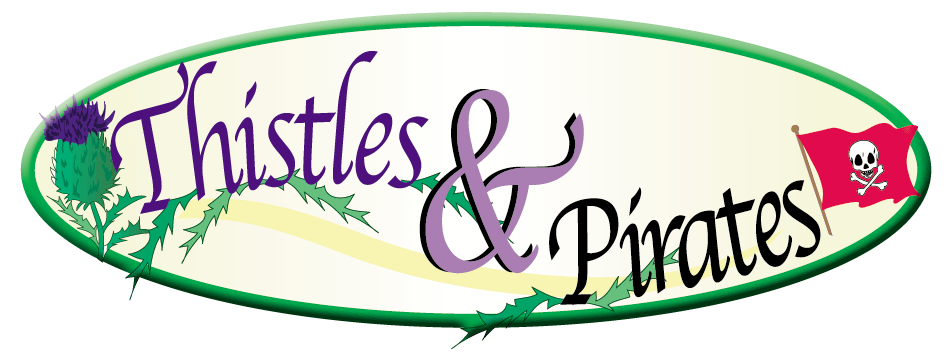 |
| Cindy
Vallar
Author,
Columnist,
& Editor |
 |
|
|
|
|
Before the Age of Sail
The Age of Sail Workshop primarily examines wooden sailing ships and maritime trade from 1600 to 1850, But participants often ask questions about vessels before this period. (The actual Age of Sail covers 1650 to 1850.) Since I'm often asked questions about earlier ships, this page is devoted to vessels built before 1600. This page is a work in progress. As time permits, I will explore earlier periods. At present the focus is on the Age of Exploration in the 1500s.
Elizabeth II
Sir Walter Raleigh
(c. 1552-1618)
During a span of six years, Sir Walter Raleigh invested more than £40,000 in expeditions to colonize North America. The second voyage set sail in April 1585. Six hundred men were aboard six vessels, one of which was the Elizabeth. The expedition's leader was Sir Richard Grenville, Raleigh's cousin, and their destination was a region named Virginia, in honor of Queen Elizabeth, the Virgin Queen. They arrived on Roanoke Island (today part of North Carolina) by July, but the following month Grenville decided to return to England with all but 100 men because most of their supplies were lost when a ship grounded.
In charge of those left behind was Ralph Lane, who explored the area with his men. Relations with the Croatans soured, and on a surprise attack of the tribal village, the English killed the chief. With dwindling supplies and the threat of further hostilities, Lane decided he and his men should leave the island when Sir Francis Drake's ships arrived after successfully raiding Spanish settlements. The colonists departed on 18 June 1586.
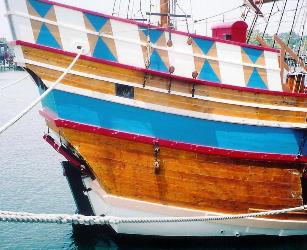 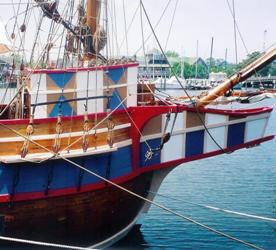 Elizabeth II, aft and fore |
| Modeled after the
original Elizabeth,
this replica is a
square-rigged bark with three masts. She is sixty-nine
feet long and
seventeen feet wide. Her draft is eight feet, meaning
that's the
minimal amount of water in which must be in order not
to run aground. |
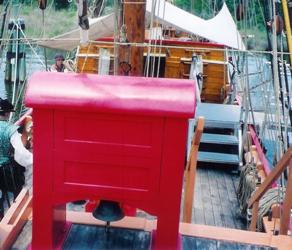 (Standing
on the quarterdeck looking toward the bow)
The
bittacle
(red object) houses the ships' compass and other
navigational aids.
This is one area where the navigator stood. The
ship's bell hangs
beneath the bittacle.
|
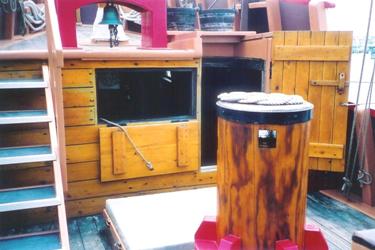 Directly
beneath the
quarterdeck is the sterncastle, which was divided
into two compartments, one in front of the other.
The first compartment
(the narrower of the two) is where the helmsman
steered the ship. The
rectangular opening in the front wall permitted
him to see the sails,
but not the ocean in front of him. Lookouts and
the navigator provided
him with any necessary data he needed to keep a
safe course. The
opening could be shuttered in foul weather. Entry
into the sterncastle
was through the hatch (door) to the right.
|
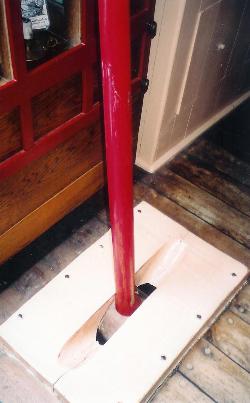 Rather than using
a ship's
wheel to steer the Elizabeth II,
helmsmen of this period used a whipstaff, a long
pole in the steerage
cabin. The whipstaff was connected to the tiller,
which was connected
to the rudder. Both of thesewere located on the deck
below.
|
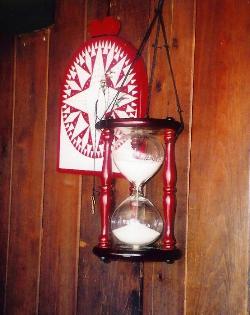 The sandglass was
used to
tell time aboard a ship, while the traverse board
was used to keep
track of a ship's location during each watch. A
seaman placed pegs in
the
appropriate
holes to record her
direction and speed. The compass provided
directional information while
the chip-log, a weighted
board
attached to a line, was used to determine her speed.
At the end of the
watch either the master or navigator recorded the
information on the
traverse
board in the ship's log, then removed the pegs so
the next watch
could collect the data all over again.
|
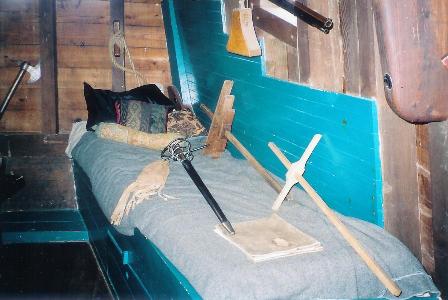 The only private
cabin
aboard the Elizabeth
II is
the master or captain's cabin. The wooden objects on
the right of his
berth are cross staffs, tools that allowed the
navigator to compute the
ship's latitude.
|
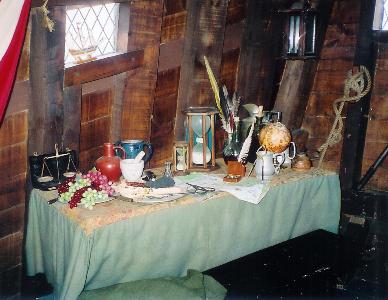 Although sparse,
the
furnishings of the master's cabin were posh and
spacious compared to
those of everyone else aboard. This table served
many purposes. Not
only could he dine at it, but he could study charts
and ecord daily
happenings in the ship's log using quill pens.
|
Located beneath the sterncastle is the tiller. The left picture shows a closeup of it, which extends out the stern where it is attached to the rudder. The right picture is a longshot view taken from the guns and men lived.
Galley Stove on gun deck
Buckets containing beef lard (used for grease) and beeswax (used for waterproofing)
Bowsprit holding a small spritsail
The two masts seen here are the mizzenmast and the mainmast. The mizzenmast carried a lateen sail, which is why the spar holding it is tilted. The mainmast is the tallest one on the bark and is situated near the center. Near the top of this mast is a bowl-like top that lookouts used to warn those on deck of impending danger, a sighted sail, or approaching land. Although often referred to as a crow's nest, Elizabethan seamen would not have used this term because the word didn't yet exist.
To ferry men and cargo to or from the shore, ships carried or towed longboats with them.
Susan Constant, Godspeed, and Discovery
On 20 December 1606, three vessels left England bound for New World. The captain of the expedition was Christopher Newport, a navigator. He and the colonists reached the Virginia colony on 30 April 1607, and on 13 May founded Jamestown in honor of King James I of England. In spite of the many hardships the settlers would endure in the coming years, Jamestown became the first successful English colony in what eventually became the United States.
Left to right: Godspeed, Discovery, and Susan Constant
The pictures above show the recreations of the original vessels, two ships and a pinnace (Discovery). The Susan Constant shows the forecastle, the boxlike structure before the foremast. She and the Godspeed returned to England in June 1607, but Discovery remained in Virginia so the colonists could sail the Chesapeake Bay and explore the coast. While the Elizabeth's platform used by lookouts was shaped like a bowl, the platforms for these vessels lacked the raised sides. The white awning on the Discovery is canvass rigged to provide shelter from the elements.
Vessels of this period did not have steering wheels, which don't appear on ships until the eighteenth century. Like the Elizabeth, the Jamestown ships used a tiller, which was attached to a rudder to steer them. The left and center picture show the tillers of the Discovery and Susan Constant. While the helmsman held the Discovery's tiller directly, that of the other vessel was attached to a whipstaff located in the aftercastle. That tiller was located belowdeck, whereas the Discovery's was open to the elements. The right picture shows the Godspeed's rudder. If you wanted the vessel to turn to starboard, you turned the tiller to port.
To hoist and haul ships have either a capstan or a windlass. The capstan has a vertical axis, whereas the windlass's is horizontal. Many vessels of this period were too small to house a capstan, so a pinnace like Discovery used the windlass (below). In the picture below notice the small squares to the right and left of the center cable (rope). Pawls (poles) were inserted into these to make the windlass revolve. Whatever was attached to the windlass's cable would then be lifted up.
This is where the helmsman stood aboard the Susan Constant to steer the ship. Notice the small window that provides a view of the forecastle. Vessels that used the whipstaff (the pole that divides the window in half) required that it be higher than the tiller, but not far from it. Rather than being able to see where he was going, the helmsman could view the sails. The navigator or master stood on deck above him and directed the helmsman.
The cabinet below the window is the binnacle, which housed the compass (far left in the box). Also kept here were sandglasses of various sizes.
To the right of the binnacle, hanging on the wall, is a traverse board. This was used to record the ships' direction and speed. Eventually this information was recorded in a log, then the pegs and strings were removed and the process began all over again.
Beneath the traverse board is a log line, which was used to determine how fast a ship sailed. This rope, which was knotted at regular intervals, was thrown overboard from the bow. At the same time a thirty-second sandglass was turned over. Once the sand ran out, the line was hauled back in and the knots counted. This information was put into a calcuation to determine the speed of the vessel, which was then recorded on the traverse board.
Sleeping arrangements on tween deck for passengers aboard Susan Constant. The only privacy was from the canvas curtains strung around the bed shelves.
These two views of Susan Constant's gallery show where the master or captain could walk with privacy around the stern.
Doors on either side provide access, but there was a high board overwhich he had to step to gain access to the gallery.
Thistles & Pirates Workshops Pirates & Privateers Copyright ©2010-2011 Cindy Vallar